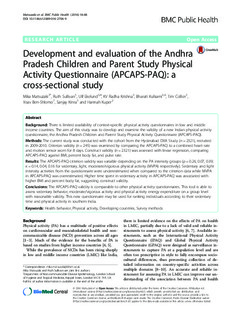| dc.description.abstract | Background: There is limited availability of context-specific physical activity questionnaires in low and middle income countries. The aim of this study was to develop and examine the validity of a new Indian physical activity questionnaire, the Andhra Pradesh Children and Parent Study Physical Activity Questionnaire (APCAPS-PAQ). Methods: The current study was conducted with the cohort from the Hyderabad DXA Study (n = 2321), recruited in 2009-2010. Criterion validity (n = 245) was examined by comparing the APCAPS-PAQ to a combined heart rate and motion sensor worn for 8 days. Construct validity (n = 2321) was assessed with linear regression, comparing APCAPS-PAQ against BMI, percent body fat, and pulse rate. Results: The APCAPS-PAQ criterion validity was variable depending on the PA intensity groups (ρ = 0.26, 0.07, 0.39; к = 0.14, 0.04, 0.16 for sedentary, light, moderate/vigorous physical activity (MVPA) respectively). Sedentary and light intensity activities from the questionnaire were underestimated when compared to the criterion data while MVPA in APCAPS-PAQ was overestimated. Higher time spent in sedentary activity in APCAPS-PAQ was associated with higher BMI and percent body fat, suggesting construct validity. Conclusions: The APCAPS-PAQ validity is comparable to other physical activity questionnaires. This tool is able to assess sedentary behavior, moderate/vigorous activity and physical activity energy expenditure on a group level with reasonable validity. This new questionnaire may be used for ranking individuals according to their sedentary time and physical activity in southern India. | nb_NO |
